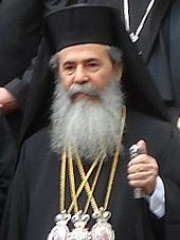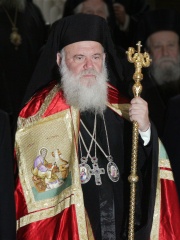







The Most Famous
RELIGIOUS FIGURES from Greece
This page contains a list of the greatest Greek Religious Figures. The pantheon dataset contains 3,187 Religious Figures, 49 of which were born in Greece. This makes Greece the birth place of the 13th most number of Religious Figures behind Poland, and Israel.
Top 10
The following people are considered by Pantheon to be the top 10 most legendary Greek Religious Figures of all time. This list of famous Greek Religious Figures is sorted by HPI (Historical Popularity Index), a metric that aggregates information on a biography's online popularity. Visit the rankings page to view the entire list of Greek Religious Figures.

1. Saint Stephen (1 - 36)
With an HPI of 84.00, Saint Stephen is the most famous Greek Religious Figure. His biography has been translated into 64 different languages on wikipedia.
Stephen (Greek: Στέφανος, romanized: Stéphanos, lit. 'wreath, crown'; c. AD 5 – c. 34) is traditionally venerated as the protomartyr or first martyr of Christianity. According to the Acts of the Apostles, he was a deacon in the early church at Jerusalem who angered members of various synagogues by his teachings. Accused of blasphemy at his trial, he made a speech denouncing the Jewish authorities who were sitting in judgment on him and was then stoned to death. Saul of Tarsus, a Pharisee and Roman citizen who would later become Paul the Apostle, was also involved as a witness in Stephen's execution. The only source for information about Stephen is the New Testament book of the Acts of the Apostles. Stephen is mentioned in Acts 6 as one of the Greek-speaking Hellenistic Jews selected to administer the daily charitable distribution of food to the Greek-speaking widows. The Catholic, Anglican, Oriental Orthodox, Eastern Orthodox, and Lutheran churches and the Church of the East venerate Stephen as a saint. Artistic representations often show Stephen with a crown symbolising martyrdom, three stones, martyr's palm frond, censer, and often holding a miniature church building. Stephen is often shown as a young, beardless man with a tonsure, wearing a deacon's vestments.

2. Pope Sixtus II (215 - 258)
With an HPI of 79.64, Pope Sixtus II is the 2nd most famous Greek Religious Figure. His biography has been translated into 80 different languages.
Pope Sixtus II (Greek: Πάπας Σίξτος Β΄), also written as Pope Xystus II, was bishop of Rome from 31 August 257 until his death on 6 August 258. He was killed along with seven deacons, including Lawrence of Rome, during the persecution of Christians by the Emperor Valerian.

3. Pope Eleutherius (171 - 189)
With an HPI of 77.55, Pope Eleutherius is the 3rd most famous Greek Religious Figure. His biography has been translated into 78 different languages.
Pope Eleutherius (Greek: Ελευθέριος; died 24 May 189), also known as Eleutherus (Greek: Ελεύθερος), was the bishop of Rome from c. 174 until his death in 189. His pontificate is alternatively dated to 171–185 or 177–193. He is venerated as a saint in the Catholic Church. He is linked to a number of legends, one of them credited him with receiving a letter from "Lucius, King of Britain". As of 2025, he is the only Pope named Eleutherius.

4. Pope Dionysius (200 - 268)
With an HPI of 76.42, Pope Dionysius is the 4th most famous Greek Religious Figure. His biography has been translated into 77 different languages.
Pope Dionysius (Greek: Διονύσιος) was the bishop of Rome from 22 July 259 AD to his death on 26 December 268. His task was to reorganise the Catholic Church, after the persecutions of Emperor Valerian I, and the edict of toleration by his successor Gallienus. He also helped rebuild the churches of Cappadocia, devastated by the marauding Goths.

5. Demetrius of Thessaloniki (270 - 306)
With an HPI of 76.26, Demetrius of Thessaloniki is the 5th most famous Greek Religious Figure. His biography has been translated into 37 different languages.
Saint Demetrius (or Demetrios) of Thessalonica (Greek: Ἅγιος Δημήτριος τῆς Θεσσαλονίκης, Hágios Dēmḗtrios tēs Thessaloníkēs), also known as the Holy Great-Martyr Demetrius the Myroblyte (meaning 'the Myrrh-Gusher' or 'Myrrh-Streamer'; 3rd century – 306), was a Greek Christian martyr of the early 4th century AD. During the Middle Ages, he came to be revered as one of the most important Orthodox military saints, often paired with Saint George of Lydda. In the Roman Catholic Church he is most commonly called Demetrius of Sirmium and his memorial is 9 April in the 2004 Roman Martyrology and 8 October in the martyrology of the Extraordinary Form. It is debated whether Demetrius of Thessalonica and Demetrius of Sirmium are the same person.

6. Pope Hyginus (100 - 142)
With an HPI of 75.67, Pope Hyginus is the 6th most famous Greek Religious Figure. His biography has been translated into 78 different languages.
Pope Hyginus (Greek: Υγίνος) was the bishop of Rome from c. 138 to his death in c. 142. Tradition holds that during his papacy he determined the various prerogatives of the clergy and defined the grades of the ecclesiastical hierarchy. Hyginus instituted godparents at baptism to assist the baptised during their Christian life. He also decreed that all churches be consecrated. He is said to have died a martyr, though no records verify this. The chronology of the early bishops of Rome cannot be determined with any degree of exactitude today.

7. Dionysius the Areopagite (100 - 100)
With an HPI of 73.94, Dionysius the Areopagite is the 7th most famous Greek Religious Figure. His biography has been translated into 40 different languages.
Dionysius the Areopagite (; Ancient Greek: Διονύσιος ὁ Ἀρεοπαγίτης Dionysios ho Areopagitēs) was an Athenian judge at the Areopagus Court in Athens, who lived in the first century. A convert to Christianity, he is venerated as a saint by multiple denominations.

8. Athenagoras I of Constantinople (1886 - 1972)
With an HPI of 73.41, Athenagoras I of Constantinople is the 8th most famous Greek Religious Figure. His biography has been translated into 33 different languages.
Athenagoras I of Constantinople (Greek: Αθηναγόρας Αʹ), born Aristocles Matthaiou Spyrou (Greek: Αριστοκλής Ματθαίου Σπύρου; 6 April 1886 (25 March) – 7 July 1972), was Greek Orthodox Archbishop of North and South America from 1930 to 1948 and the 268th Ecumenical Patriarch of Constantinople from 1948 to 1972.

9. Saint Titus (13 - 107)
With an HPI of 73.32, Saint Titus is the 9th most famous Greek Religious Figure. His biography has been translated into 38 different languages.
Titus ( TY-təs; Ancient Greek: Τίτος, Títos) was an early Christian missionary and church leader, a companion and disciple of Paul the Apostle, mentioned in several of the Pauline epistles including the Epistle to Titus. He is believed to be a Gentile converted to Christianity by Paul and, according to tradition, he was consecrated as Bishop of the Island of Crete. Titus brought a fundraising letter from Paul to Corinth, to collect for the poor in Jerusalem. According to Jerome, Titus was the amanuensis of this epistle (2 Corinthians). Later, on Crete, Titus appointed presbyters (elders) in every city and remained there into his old age, dying in Gortyna.

10. Philomena (291 - 304)
With an HPI of 73.04, Philomena is the 10th most famous Greek Religious Figure. Her biography has been translated into 31 different languages.
Philomena ( FIL-ə-MEE-nə), also known as Saint Philomena (Ancient Greek: Ἁγία Φιλουμένη, romanized: Hagía Philouménē; Modern Greek: Αγία Φιλομένα, romanized: Agía Filoména) or Philomena of Rome (c. 10 January 291 – c. 10 August 304) was a virgin martyr whose remains were discovered on 24–25 May 1802, in the Catacomb of Priscilla. Three tiles enclosing the tomb bore an inscription, Pax Tecum Filumena (i.e. "Peace be unto you, Philomena"), that was taken to indicate that her name (in the Latin of the inscription) was Filumena (Ancient Greek: φιλουμένη, romanized: philouménē, lit. 'beloved'), the English form of which is Philomena. Philomena is the patroness saint of babies, infants, and youth, and is known as "The Wonderworker". The remains were moved to Mugnano del Cardinale in 1805. There, they became the focus of widespread devotion; several miracles were credited to Philomena's intercession, including the healing of Pauline Jaricot in 1835, which received wide publicity. John Vianney attributed to her intercession the extraordinary cures that others attributed to him. From 1837 to 1961, celebration of her feast day was approved for regional calendars, but was never included in the General Roman Calendar. The 1920 typical edition of the Roman Missal included a mention of her, under 11 August, in the section headed Missae pro aliquibus locis ("Masses for some places"), with an indication that the Mass to be used in those places was one from the common of a virgin martyr, without any proper. The Coptic Orthodox Church celebrates the feast of Saint Philomena on 10 August of the Gregorian calendar, which is 4 Misra of the Coptic calendar.
People
Pantheon has 49 people classified as Greek religious figures born between 600 BC and 1956. Of these 49, 4 (8.16%) of them are still alive today. The most famous living Greek religious figures include Patriarch Theophilos III of Jerusalem, Patriarch Theodore II of Alexandria, and Ieronymos II of Athens. The most famous deceased Greek religious figures include Saint Stephen, Pope Sixtus II, and Pope Eleutherius.
Living Greek Religious Figures
Go to all RankingsPatriarch Theophilos III of Jerusalem
1952 - Present
HPI: 66.24
Patriarch Theodore II of Alexandria
1954 - Present
HPI: 63.51
Ieronymos II of Athens
1938 - Present
HPI: 59.65
Theodoros Kontidis
1956 - Present
HPI: 50.43
Deceased Greek Religious Figures
Go to all RankingsSaint Stephen
1 - 36
HPI: 84.00
Pope Sixtus II
215 - 258
HPI: 79.64
Pope Eleutherius
171 - 189
HPI: 77.55
Pope Dionysius
200 - 268
HPI: 76.42
Demetrius of Thessaloniki
270 - 306
HPI: 76.26
Pope Hyginus
100 - 142
HPI: 75.67
Dionysius the Areopagite
100 - 100
HPI: 73.94
Athenagoras I of Constantinople
1886 - 1972
HPI: 73.41
Saint Titus
13 - 107
HPI: 73.32
Philomena
291 - 304
HPI: 73.04
Antipope Alexander V
1339 - 1410
HPI: 72.58
Saint Giles
640 - 710
HPI: 72.04
Overlapping Lives
Which Religious Figures were alive at the same time? This visualization shows the lifespans of the 10 most globally memorable Religious Figures since 1700.







